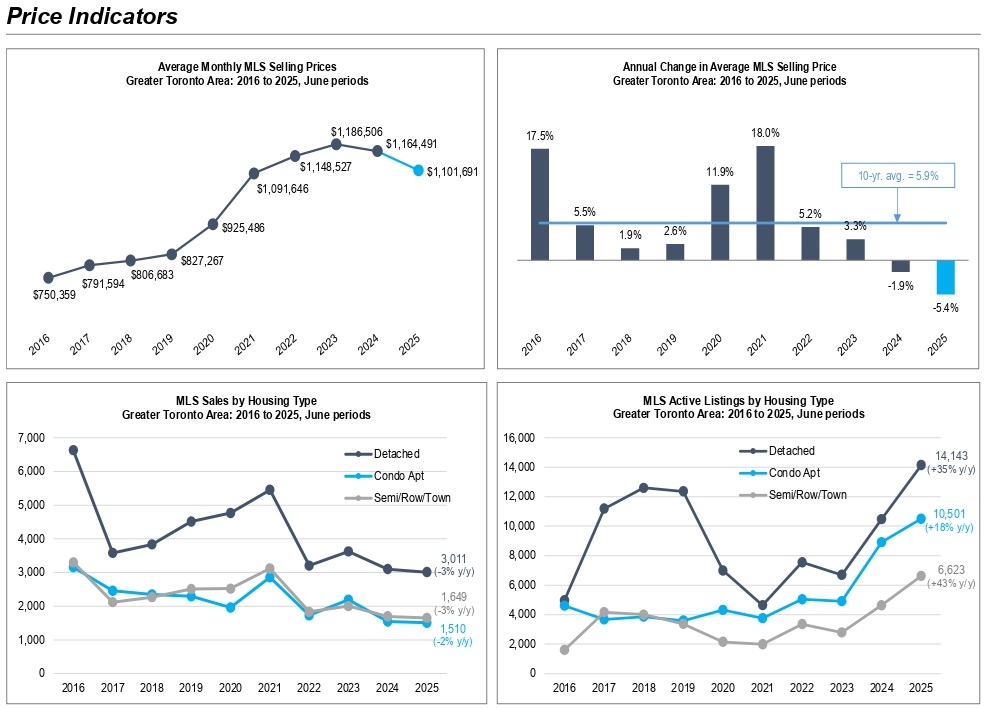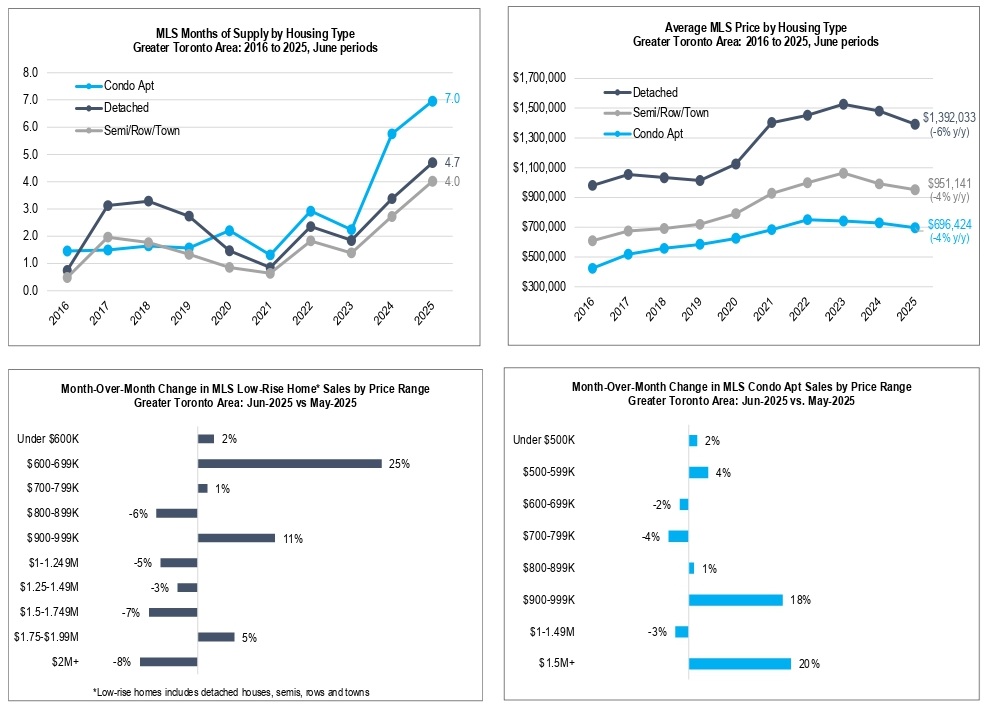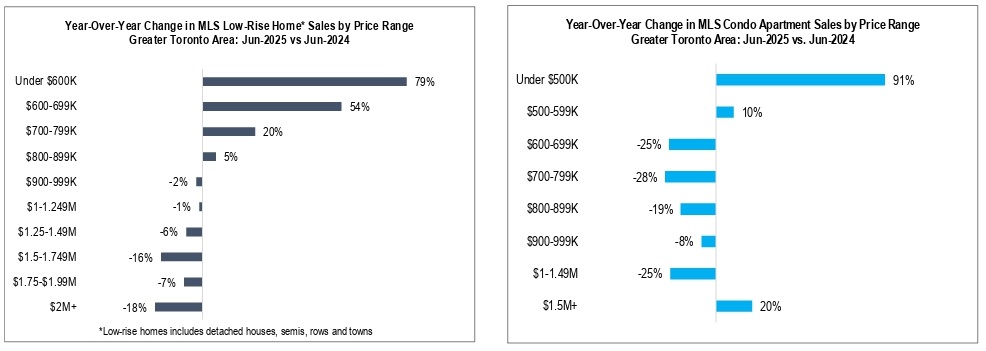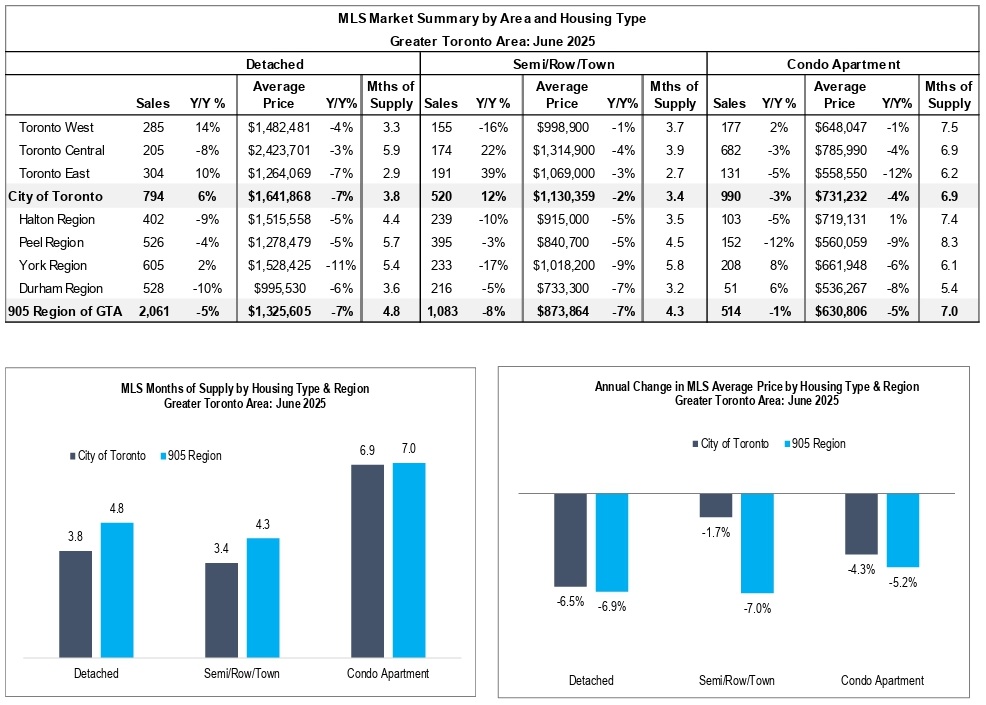
July 2025 GTA Monthly Housing Report
Buyers Slowly Returning as Supply Weighs Down Prices
Sales momentum improved month-to-month for the third month in a row in June but remained at exceptionally low levels as buyers continued to hesitate amid heightened economic uncertainty and sticky interest rates. As supply levels rose to another record high, annual price declines accelerated. However, despite the weakness in the market, prices have shown a high level of resiliency over the past two years.
Sales Continue to Gradually Improve: Total MLS sales reached their highest point of the year at 6,243 transactions in June, rising 8.1% from May on a seasonally adjusted basis. Compared to a year ago, sales were 2% lower, which was the smallest year-over-year decrease so far this year. Historically, sales were at their lowest June level of the past 25 years, falling 29% below the latest 10-year average. For the first half of 2025, sales were down 18% from 2024.
Active Listings More than Doubled in Past Two Years: New listings continued to trend higher in June, increasing 8% annually to 19,839 homes — the highest June level since 2017 and 11% higher than the 10-year average. This resulted in the number of active listings on the market at month-end reaching another record high at 31,603 homes, up 31% from a year ago and more than double the level from two years ago.
Conditions Heavily Favour Buyers: The ratio of sales-to-new listings remained at a 30-year low in June at 31%, signalling strong buyers’ market conditions. Months of supply continued to move higher in June, rising to 5.1 months from 3.8 months a year ago. Months of supply was more than double the 10-year average of 2.3 months.
Price Declines Steepen: Price declines became steeper in June as the average MLS selling price decreased 5.4% year-over-year, compared to a 4.0% annual decline recorded in May. At $1,101,691, average prices were down 7.1% over the past two years and effectively back to their June 2021 level. On a seasonally adjusted basis, prices were effectively flat (-0.1%) month-over-month from May. The rolling 10-year average annual rate of price growth slowed to 5.9%, down from 7.6% a year ago.

Price Indicators
Condo Sales Fall 32% Below 10-Year Average:
Sales slowed over the past year at similar speeds across all housing types, with sales of detached and semi/row/town homes both decreasing 3% and condo apartment sales down 2%. Detached and semi/row/town sales were both 28% below their 10-year average, while condo apartment sales were 32% below their decade average.
Active Listings for Semis/Rows/Towns Reach Record High:
Despite new listings for condo apartments decreasing 2% year-over-year in June, active listings at month-end grew 18% from a year ago to a record high 10,501 units. New listings for detached homes rose 11% annually in June, pushing active listings up 35% from a year ago to 14,143, the highest level since 2008. Active listings for semis/rows/towns increased the most over the past year, rising 43% to a record-high 6,623 homes.

Condo Supply Remains at Seven Months:
Condo inventory remained at seven months of supply for the second month in a row in June, up from 5.8 months last year and the highest level since the Global Financial Crisis in late 2008/early 2009. Detached inventory grew to 4.7 months in June, compared to 3.4 months a year ago, while inventory for semis/rows/towns reached the threshold between a balanced and buyers’ market at four months of supply, rising quickly from 2.7 months of supply in June 2024 and just 1.4 months of supply in June 2023.

Condo Prices Steadier than Other Housing in Past Two Years:
Average prices decreased the most over the past year for detached homes with a 6% annual decline to $1,392,033, while average prices for both semis/rows/towns and condo apartments both decreased 4% annually to $951,141 and $696,424, respectively. Remarkably, condo apartment prices have held up better than other housing types over the past two years with a decline of 6%, compared to two-year declines of 9% for detached homes and 11% for semis/rows/towns.
Sales Trending Up for Affordable Low-Rise Homes and Higher-end Condos:
Between May and June, sales growth was strongest for low-rise homes priced $600–699K with a 25% month-over-month increase. This was followed by a 20% monthly increase in sales of the most expensive condo apartments priced $1.5M-plus.

Condo Sales Under $500K Nearly Double from Last Year:
Year-over-year, sales increased the most for the least expensive condo apartments priced under $500K with growth of 91%, followed by 79% annual growth for the most affordable low-rise homes priced below $600K. Strong year-over-year sales increases were also recorded for low-rise homes priced $600–699K (+54%) and $700–700K (+20%), as well as high-end condos priced $1.5M-plus (+20%). Meanwhile, the largest annual declines for low-rise sales were for homes priced $2M-plus (-18%), with annual sales declines of 25% or higher seen for condo apartments priced between $600–799K and $1–1.49M.
Low-Rise Home Sales in Toronto Increase:
Detached houses in the City of Toronto experienced growth in sales over the past year, with activity up 6%. Sales of semis/rows/towns in Toronto increased even faster with 12% annual growth in June. Meanwhile, condo apartment sales declined 3% from a year ago in Toronto, and sales of all housing types were down annually in the 905 Region, led by an 8% decrease in sales of semis/rows/towns.
Months of Supply Lowest for Semis/Rows/Towns in Toronto:
The largest annual price declines of 7% were experienced by detached homes in Toronto and the 905, as well as semis/rows/towns in the 905 Region. Average prices held up best for semis/rows/towns in Toronto with a 2% annual decline. Across all housing segments in the GTA, months of supply was lowest for semis/rows/towns in Toronto at 3.4 months and highest for condo apartments in the 905 Region at 7.0 months.

Key Takeaways
Demand Rebounding Slightly:
Data over the past three months indicates that demand has been slowly but steadily moving off the sidelines following a plunge in consumer confidence in February and March during the onset of a volatile trade conflict with the U.S. As the housing market enters the high point of summer during the next two months, activity will likely remain slow from a historical context.
Uncertainty Still Looms:
Despite some signs of progress towards a trade deal that will limit economic damage for Canada, businesses continue to operate cautiously given the constantly evolving situation. Canada’s unemployment rate reached 7% in May, the highest it’s been in nine years outside of the pandemic.
Rates May Drop Again:
As the economic data continues to soften (GDP estimates for April and May showed monthly declines), the Bank of Canada will likely be compelled to continue lowering interest rates if inflation remains subdued (it held steady at 1.7% in May). Most economists expect the Bank to resume interest rate cuts in late 2025 or early 2026, potentially bringing the policy rate down from its current level of 2.75% to 2.25% or 2.00% by the end of next year.
Market Outlook
Affordability Improving but Still a Hurdle:
At current prices, mortgage rates in the low-to-mid 4% range are still considered somewhat high. Even though affordability has improved over the past year, through a combination of lower prices, lower interest rates, and the availability of longer amortizations, further improvement is likely needed to move more buyers off the sidelines in an uncertain economic environment.
Sales May Rebound Later in the Year:
As interest rates move lower later this year and prices likely continue to soften in the near-term given the record level of supply on the market, demand should begin responding more earnestly and the modest momentum seen for sales in recent months should gain speed.
Some Segments Already Recovering:
It is encouraging to see that certain segments of the market are already growing again, including low-rise homes in Toronto, affordably priced homes in the 905, and entry-level and higher-end condos. Price declines have been relatively modest across all housing categories and market areas, including the most over-supplied segment in condos, illustrating the underlying resilience and strength of the GTA housing market.
